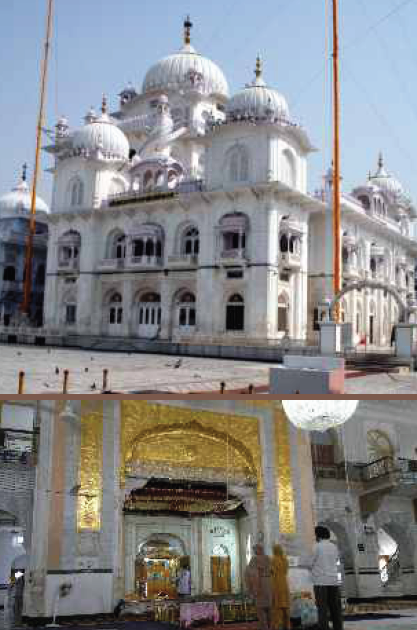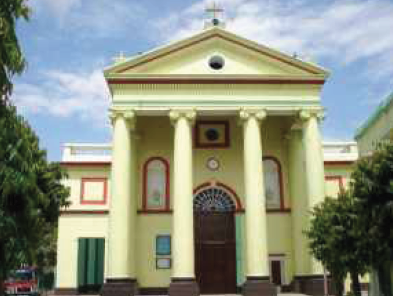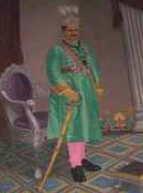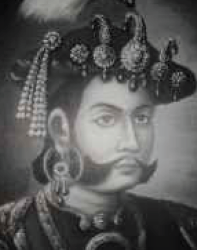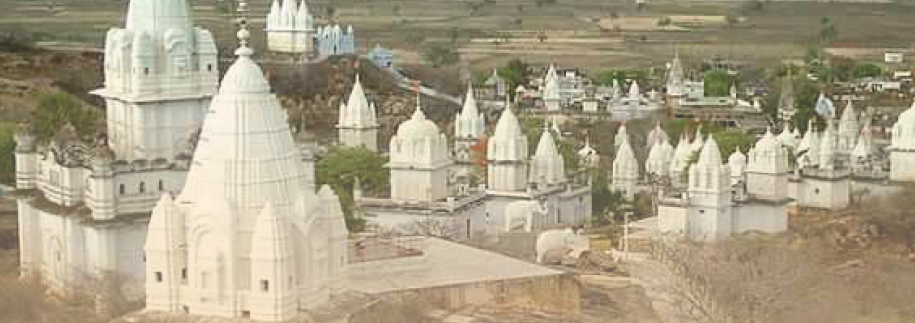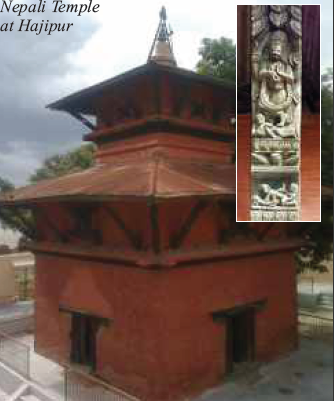Ganga: Patna - Hajipur – Vaishali
This is a collection of articles archived for the excellence of their content. Readers will be able to edit existing articles and post new articles directly |
Ganga
...and quiet flows the Ganga
Patna - Hajipur – Vaishali
India Harmony VOLUME - 1 : ISSUE - 6 SEPTEMBER-OCTOBER, 2012
By Vinita Gardner
Walking down the labyrinthine alleys of Time, we find encapsulated in the annals of history, a melange of marvellous cities, linked each to the other by the tensile cords of a cultural homogeneity....
A panoply of treasures to beguile the mind and persuade it to explore Patna's rich heritage further, this capital city of Bihar, Patna, in ancient times known as Patliputra, is among the world's oldest capital cities with an unbroken history of many centuries as an imperial metropolis! A very fertile arched stretch of land along the bank of the Ganges, the history and heritage of modern day Patna go back well over two millennia! Like Delhi, Patna too had been the regal seat of governance for successive kingdoms since ancient times.
Known as Patliputra then, it played host to the rulers of the Magadha Empire under the Haryanka, Nanda, Mauryan, Sunga, Gupta and Pala dynasties and, during the Islamic period, was the sustained seat of power for the Suri dynasty.
The modern city of Patna is situated on the southern bank of the Ganges. The city also straddles the rivers Sone, Gandak and Punpun. Approximately 35 km long and 16 km to 18 km wide, the walled old area, known locally as Patna City, is a major trading centre. It is also an important business and luxury brand centre of eastern India. In recent years, the economy of Patna has seen sustained economic growth, spurred on, in particular, by remarkable growth in the fast moving Consumer Goods Industry, the service sector, along with Green Revolution businesses.
Believed to be the fifth fastest growing city in India and blessed with a rich historical and cultural heritage, the beautiful city of Patna, sprawled graciously over an area of 3,202 sq. kilometres, is fast becoming a major tourist attraction! This ancient centre of pantheistic significance, Patna offers travelers a rich panoply of treasures in the multi-faith Buddhist, Hindu, and Jain pilgrim centres of Vaishali, Rajgir, Nalanda, Bodhgaya, and Pawapuri nearby.
Patna is also a sacred city for Sikhs and houses the Har Mandir Takht - one of the 4 sacred shrines of the Sikhs built by Maharaja Ranjit Singh to commemorate the birth of Guru Gobind Singh here in 1660 A.D. Situated in the heart of Patna city, it has preserved the many precious Sikh scriptures, relics and artifacts related to the sacred Guru, housed in it, with utmost care. Maintaining the sanctity of their relevance for the thousands of Sikh devotees who sojourn here religiously to revere the belongings of the tenth Sikh Guru at Takht Sri Patna Sahib.
Padri ki Haveli where Mother Teresa got her training, the beautiful Sher Shah Suri Masjid, built in Afghan architectural style, the 212 years old Khuda Baksh Oriental Library, a magnificent one man collection of rare Arabic and Persian manuscripts, Rajput and Mughal paintings and Mahatma Gandhi Setu, Asia's longest roadway bridge juxtaposed homogenously with the Modern Planetarium and Sanjay Gandhi Biological Park, all vie for our attention! As does the unique Darbhanga House with its genesis rooted in royalty and their munificence, its gift to posterity! Known earlier as the NavLakha Palace of the Darbhanga kings, it was constructed by Maharaja Kameshwar Singh Bahadur who ruled from 1929 to 1947 when, after independence, the state was merged into the Union of India. The royal family, in consonance with their liberal policy of patronage towards education, donated the college to Patna University!
Dreaming by the banks of the generous Ganges, the gracious edifice of Darbhanga House, has as its chief feature a beautiful temple built on the premises of the palace and dedicated to Goddess Kali. The Maharaja Kameshwar Singh Bahadur himself was a dedicated devotee of the Goddess and religiously offered prayers here. The Kali Mandir at Darbhanga House and the Patna Kali Bari at Yarpur are the two most sought after Kali temples in Patna, particularly during Dussehra!
Like the Darbhanga House, there are many other] palaces of the Darbhanga royal family that have been donated towards the promotion of education to various institutes. Some of these palaces are:
Nargona Palace- this palace is now a part of the L.N.Mithila University.
Lakshmi Vilas Palace- this is the seat of education for the Kameshwar Singh Sanskrit University.
Bela Palace- The Postal Training College holds classes in this palace.
Blessed by their divine deities and inspired by the benevolence of their erstwhile monarchs, these educational institutions flourish, offering enlightenment to mankind and a tradition of royal munificence!
A quaint mixture of sites of archaeological relevance and contemporary leisure amenities such as the Patna Museum with its assortment of bronze and stone sculptures and a host of terracotta figures belonging to the ancient Hindu and Buddhist artists in India; libraries, boating clubs, attractive shopping malls and cinemas, all offer an amazing potpourri of attractions to choose from in Patna, to cater to the whims of every eager traveller, to satiate the search for a satisfactory perspective to its historicity.
[[File: Elephants at the Sonepur Fair.png| Elephants at the Sonepur Fair|frame|500px]
Linked to the medieval city of Hajipur – a mere 10 kms from Patna - by the 6.75km long Mahatma Gandhi Setu river bridge which forms an important link between north and south Bihar, Hajipur was originally known as Ukkacala in ancient times.
Founded by a King of Bengal named Haji Ilyas Shah who ruled between 1345 A.D. to 1358 A.D., it was the first village to come after crossing the River Ganges at Patna. The village of Hajipur Mahatma Gandhi Sethu gained significance as it was the venue of one of the discourses given by Lord Buddha. Buddha preached the Cula Goplalaka Sutta, a Middle Length Discourse, here. An additional point of interest was that a portion of the ashes of Ananda, Lord Buddha's closest disciple, were enshrined in the town.
Headquarters of the important Vaishali district, Hajipur, bound by the Narayani Gandak river in the west and the holy Ganges in the south, has a commendable network of rail, road and water transport linking it effortlessly with other parts of the district, State and country.
Famous for producing bananas, the plain terrain of the town and its environs are aflush with a bonanza of banana, litchi and mango plantations, exhorting fruit lovers to sample their luscious offerings!
It is only fitting that we commence our voyage of discovery in this city of religious significance, with a visit to Shri Maha Prabhuji's Baithakji at Helabazar, Hajipur.
Lord Krishna Temple (Aacharya Prabhuji Ki Baithak) is one of the oldest temples of Hajipur visited by innumerable vaishnavs every year. There are 84 Mahaprabhuji Baithaks in India. Commemorating the life and times of the Acharya, who travelled tirelessly conducting Shrimad Bhagwat seminars, debating with scholars and heads of other religions and establishing the ethics of “Shudhadvaita Brahmavada” . Travelling by rail and road through hazardous terrain sometimes, vaishnavs religiously journey to pay obeisance and perform “seva”.
Witness an effulgent
dawn at the famous
Sonepur Fair, in close
proximity to Hajipur
and a mere 25 kms
from Patna, the
capital of Bihar!
Easily accessible
from both places by
road, rail and air
(from Patna), one of
the largest animal fairs in Asia, conducted in an
ambience of boisterous bonhomie, it lasts for
about two weeks beginning with the full moon
night of Kartik (November).
Sonepur, situated strategically at the confluence of the holy Ganges and Gandak rivers, was in ancient times the site of camping by royal Rajahs and aristocratic Nawabs, lending it a unique historical significance! Chandragupta Maurya used to buy elephants and horses across the river Ganges! Then it attracted traders from several places as distant as Central Asia! The site of the present fair was originally at Hajipur but shifted to Sonepur during the reign of the Mughal emperor Aurangzeb.
A holy dip at the confluence of the two rivers and a visit to the Hariharnath temple here, is the highlight for thousands of devotees on Kartika Purnima day. As people jostle each other in a spirit of joyous reverence and exuberant bonhomie, savouring culinary delights from all over India, the mind travels swiftly to those days gone by, in the era of a different ruling faith....
This colourful fair cheerfully entertains visitors with a melange of activities such as folk plays, Nautanki (folk dances), games, jugglers and a captivating circus! Selling everything from elephants to birds, agricultural equipments to vanity items, winter garments to wooden furniture, the sprawling Mela ground with its pulsating market, has the widest possible range of cattle and commodities!
The large number of beautifully decorated elephants, brought here to be sold mainly to different Forest Departments, form a stunning and impressive sight! Dispelling the solemnity of purpose, however, is the overpowering cacophony of sound from India's animal kingdom - like dogs, camels, buffaloes, donkeys, ponies, monkeys, chimps, Persian horses, sheep, rabbits, bears, cats, and guinea pigs –ferried in eager anticipation to the Sonepur Fair!
The visitors can stay in hotels at Hajipur or they can hire luxury Swiss cottages erected on sand dunes beside the river Gandak, for a novel living experience! The tents and cottages are provided by the enterprising State Tourism Department only for the duration of the fair.
One can never have a surfeit of benign blessings, be it from any manifestation of the plethora of Gods that we worship! So it is at the Nepali Mandir, west of Hajipur, at the confluence of the Ganges and the Gandak, where this unique Shaivite shrine is situated.
Constructed in the late medieval period (18th century) by Mathabar Singh Thapa, one of the army commanders of Nepal, the temple brings in the refreshing pagoda-style architecture of the Himalayan Kingdom, to the plains of the Ganges! Built largely of wood, another distinctive feature of this temple is its fine wooden carving, which depicts, among other things, an abundance of amorous scenes! Both in style as well as execution, drawing predominantly from the aesthetics of the Himalayan world of architecture, Nepali Temple at Hajipur remains quite singular and inimitable!
Hajipur, which traces its origin back to the time of the famous Hindu epic, Mahabharata, presents a panorama of verdant beauty to the inveterate traveller, with an abundance of plants and trees thriving in all their natural splendour, in its semi-tropical monsoon climate.
Inside the fort built by it founder-king, Haji Ilyas Shah, there is a mosque called Jami Masjid, a plain building measuring 84.5 ft (25.8 m) long and 33.5 ft (10.2 m) broad. The mosque is crowned by 3 domes, with the central dome being larger than the others. An inscription over its stone gateway records its erection in the year 1587 A.D. during the reign of the Mughal Emperor, Akbar by Makhsus Shah. According to the Akbarnama, Makhsus Shah was the brother of Said Khan, the governor of the famous Bihar Sharif. The Jami Masjid of Hajipur is one of the most remarkable monuments belonging to the Mughal period.
And while the fortunes of “the Great Mughal” himself, Akbar, touched the lives of the peoples of Hajipur and Patna but fleetingly in the rain-soaked summer of 1574 A.D., when he camped in close proximity to these cities to crush the rebellion of the Afghan chief Daud Khan and lift the siege on Patna successfully, his munificent philosophy of religious toleration lives on in the hearts of people even today! In the eloquent words of Alfred Lord Tennyson who said in “Akbar's Dream”:
Well, I dream'd That stone by stone I rear'd a sacred fane A temple,neither Pagod, Mosque, nor Church, But loftier, simpler, always open-door'd To every breath from heaven, and Truth and Peace And Love and Justice came and dwelt therein”
But I digress…Before you move on to soak in the wonders of Vaishali and revel in its many- splendored visual gifts, there still remain a few points of pilgrimage here, in Hajipur!
The Ramchaura Mandir which is on top of the Ananda Stupa, the Hindu temple of Pataleshwara Nath on the western outskirts of Hajipur and a famous temple named Budi Maai, situated in Ismailpur (Harauli) village of Hajipur, deserve your obeisance; as does the Mahadev Math in Rajason,, situated on the bank of river Ganges. It is also a historical temple.
And, finally, Kaun Haara Ghat, which is considered one of the main ghats of Ganga- Gandak, where worshipping and cremation has been performed for centuries! Based on an ancient legend where Lord Vishnu had to intervene in the famous fight of Gaja (elephant) and Graah (crocodile), killing Graah to give him instant salvation, and saving the life of his devotee, Gajaraj, the depiction of fighting Gaja Graah is an emblem for the city; it is prominently shown on the Hajipur railway station's dome, and other notable places.
Wondrous Vaishali, which derives its name from King Vishal of the era of the memorable epic, the Mahabharata, was an ancient metropolis and the first world republic of the Licchavi state. Established in the 6th century B.C., this capital city, with its cornucopian splendor and panoply of riches, played a pivotal role in the propagation of two major world religions - namely Buddhism and Jainism! Established before the birth of the Buddha in 563 B.C., this splendid seminal republic is considered to be the forerunner of later republics found in ancient Greece! With an ambience ripe for the flowering of faith and a stronghold of the Nirgranthas (Jains), it was in the Kshatriyakund district of Vaishali that the last and 24th Tirthankara, Lord Mahavira – the founder of the Jain religion - was born in 599 B.C.to King Siddharth and his beautiful queen, Trishila. According to the Svetambaras, of the forty-two rainy seasons of the latter part of Mahavira's ascetic life, he spent twelve at Vaishali, fervently preaching and propagating his faith!
To this date, the famous Vaishali Mahotsava, celebrated with great fervour to mark the birthday of Lord Mahavira, by both the Digambara and the Shwetambara Jains, is held at Vaishali. Marked by great pomp and pageantry, grand chariot processions carrying Mahavir's image, are taken out, rich ceremonies held in temples, religious discourses held and alms generously distributed to the poor and needy!
Vaiśālī state covered most of the Himalayan Gangetic region of present-day Bihar state; and the important city of Vaishali, where Gautama Buddha preached his last sermon and announced his Parinirvana, was well connected by roads to Rajagriha in the south and to Kapilavastu and Shravasti in the north.
Buddha first visited Vaishali in the fifth year of his enlightenment and spent the entire monsoon season there. The Buddhist Theravadin Commentaries describe his inaugural visit in detail. This prosperous capital of the Vajjian Confederacy, flush with 7,707 beautiful pleasure parks, lotus ponds, an abundance of royalty with their elaborate retinues and the famous courtesan, Amrapalli, flourished in unmitigated splendor until……..it was suddenly struck by disaster!
The visit of a “Deva” such as Buddha, on Vajjian territory, brought on a cleansing thunderstorm and the evil spirits are believed to have fled in the face of his virtue! That evening Buddha himself gave a discourse on the Ratna Sutta to a massive gathering in the presence of several Lichhavi princes and 84,000 people are believed to have been converted at a stroke!
Numerous references to Vaishali are found in texts pertaining to both Jainism and Buddhism, which have preserved much information on Vaishali and the other Maha Janapadas.
Apparently Buddha visited Vaishali several times and it was during one such visit, upon his return from Kapilavastu, that his foster mother, Mahapajapati Gotami, followed Buddha with 500 other Sakya women and with the helpful intervention of his main disciple, Ananda, persuasively obtained permission for women to enter the Buddhist Sangha by observing certain parameters!
Ancient Bihar also saw the glorification of women in matters of state affairs. It was here that Amrapali (as she was later known), a courtesan of Vaishali in the kingdom of the Lichhavis, attained and wielded enormous power!
It is said that the Lord Buddha, during his visit to Vaishali, firmly refused the royal invitation of many princes, and chose to have dinner with the exotic Amrapali instead! Such was the status of women in the Bihari society several centuries ago!
A little-known, but historically and archaeologically documented, event is worth mentioning in this context. After his visit with Amrapali, Lord Buddha continued with his journey towards Kushinagar. Travelling along the eastern bank of the river Gandak, accompanied by his band of devoted Licchavis, at a spot known as Kesariya, in present East Champaran district, Lord Buddha took rest for the night. It was here that he chose to announce to his disciples the news of his impending nirvana (meaning, death); and implored them to return to Vaishali. The wildly lamenting Licchavis would have none of that and steadfastly refused to leave. Whereupon, Lord Buddha, by creating a 3,000 feet wide stream between them and himself compelled them to leave, leaving his alms-bowl as a special souvenir with them!
Pause awhile at the Abhishek Pushkarini, the coronation tank. The sacred waters of the tank anointed the elected representatives of Vaishali. Next to it stands the Japanese temple and the Vishwa Shanti Stupa (World Peace Pagoda) built by the Nipponzan Myohoji sect of Japan.
A small part of the Buddha's relics found in Vaishali have been enshrined in the foundation and in the chhatra of the Stupa. Near the coronation tank, in Stupa 1 or the Relic Stupa, the Lichchavis reverentially encased one of the eight portions of the Master's relics, which they received after the Mahaparinirvana.
Travel back in time to the Kutagarasala Vihara - the monastery where Buddha most frequently stayed while visiting Vaiśālī! It is located 3 kilometres from the relic Stupa, and on its ground can be found the Ānanda Stupa, with an Asokan pillar in very good condition (perhaps the only complete Asokan pillar left standing), and an ancient pond, proof of its antiquity!
Fittingly enough, the second great Council of Buddhists was held at Vaishali after the Buddha's death to disseminate and lay down the rules of conduct, for the followers of this divine faith.
The several important monasteries and shrines found in the historic city of Vaishali were described elaborately by the Chinese pilgrim FaXian as far back as the 5th century B.C and bear eloquent testimony to its significance as a Buddhist Centre!! The proposed resurrection of the ancient University of Nalanda (223 kms away), known as an architectural masterpiece with temples and parks, which instructed students in medicine, mathematics, astronomy and politics, is “to create a world-class institution bringing in the best of talent from all countries", said Nobel Laureate Amartya Sen, head of the project's "mentor" group. According to him it will have “schools like Buddhist studies, philosophy and comparative literature, historical studies and ecology and environmental studies.”
Symbolizing for some ”the icon of Asian renaissance” and with collaborations with other famous universities like the Al-Azhar University of Egypt, Oxford and Cambridge Universities in Britain and Harvard University in the U.S., this colossus of learning and culture, spread over 500 acres in proximity to the original huge red-brick ruins, is bound to promote harmony among peoples and greater global understanding! Weaving through the warp and weft of history with an effortless grace, knitting with dexterity the dreams and destinies of its disparate peoples into a cohesive whole, an enduring and colourful tapestry of cultures and civilizations, quiet flows the Ganga......and the Ganga flows on.....the universal “mother”.....nourishing her cosmic children towards a pulsating posterity.......!
Wastes from drains polluting the Ganga
Subhash Mishra
Jan 04 2015
Waste from 40,000 km of drains are choking the holy river
More than 40,00km long drains and subsidiaries stretched over 5,000 km carrying industrial and urban waste of dangerous level while directly falling into the 1,300-km long stretch of the Ganga are choking the holy river and stalling all efforts to rejuvenate it.Prime Minister Narendra Modi's `Namami Ganga' project, aimed at reviving the river, would remain a non-starter if the root causes of rising pollution are not addressed and innovative methods not deployed, states a report (in possession of TOI) prepared first time by the UP's irrigation department. Among the rivers merging into the Ganga, Ram Ganga, Kali Nadi Poorva, Kali Nadi Pashchim, Hindon, Gomti, Sai and Yamuna have a very high level of biological oxygen demand (the amount of dissolved oxygen needed by biological organisms in a water body to break down organic material).
UP irrigation minister Shivpal Yadav presented the report to Union minister for water resources Uma Bharati recently . The report will aid both the Centre and state to redraw their macro as well as micro strategy for rejuvenation of the Ganga, said a source in the state irrigation department.
Principal secretary irrigation Deepak Singhal told TOI that the report has been in principle accepted by the Central government. The report states that unless the root causes of the pollution in the Ganga are not addressed, mere beautification of the riverfront in Varanasi will not help, he added. “You cant treat the lung cancer by going to a dentist,“ Singhal said.
Singhal said the Centre has agreed with irrigation department's action plan which includes trapping drains by developing master drains, using treated water and fertiliser produced from it for agriculture purposes and a separate plan for every river falling into the Ganga.
BOD centric approach may not be useful, Singhal said, adding that pollution index creation and augmentation of water and change in irrigation methods for farm purposes is the thrust of the report .
